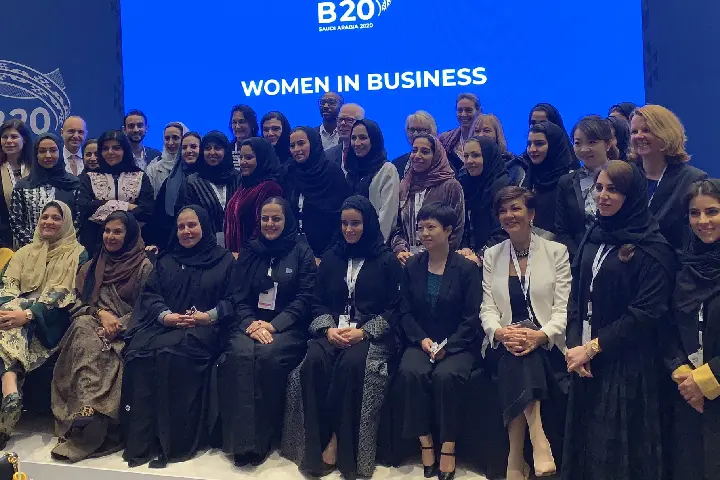

The labour force participation rate of Saudi women rose from 19.7% to 37% in the last two years.
Workplaces in conservative Saudi Arabia are turning gender equal, confirming that the kingdom is undergoing rapid reforms. According to various estimates, the labour force participation rate of Saudi women, that is to say those working or looking for work, rose from 19.7% to 37% in the last two years.
About 2.2 million Saudi men and women are working in the private sector – the highest rate in the country’s history.
Those seeking work in the kingdom comprises multiple nationalities, including Indian women. However, many jobs for these women are coming at the cost of male migrants from Asian countries.
In the hotel and restaurant sector, women now represent 40% of the workforce, says a report in reputed French newspaper Le Monde. Such a rise was unimaginable a few years ago. It was only in 2012 that women were allowed for the first time to work somewhere other than in out-of-sight offices, they were allowed to also work in stores. And not just any stores: only in lingerie and cosmetics shops.
With the 2016 launch of Vision 2030, Crown Prince Mohammed bin Salman’s economic and social reform plan, the place of women in Saudi society has been changing rapidly. Restrictions on working at night or in the industrial sector are being eased and more women are studying. Since women have been allowed to drive, for example, it has been easier for them to hold down jobs, as Brookings Institution researchers wrote in their paper, published in March. But this policy only partly explains the dramatic increase of women in the workforce.
As the Saudi economy recovered in the third quarter of 2020 after the Covid slump, companies turned to Saudi women to replace Indian, Filipino and Pakistani migrants. More Saudi women are replacing them than Saudi men because “they are more willing to work for low wages”, a report said.
Reforms and Labour
Saudi women are a vital element for the success of Vision 2030. Several reforms have been implemented to incentivize and protect women to enter the labour market, according to the World Bank Women Business and Law report. These have included equalized women’s right to choose a place of residency. They prohibited discrimination based on gender in employment, the dismissal of pregnant women and discrimination based on gender in accessing credit. The decrees introduced pension equality by equalising the retirement ages for men and women and mandating pension care credits for maternity leave.
These reforms are already benefiting 6 million Saudi women over the age of 21 and will affect women for many generations to come. Women’s employment in traditionally male dominated sectors also increased. In 2020 alone, 7,782 women entered the construction sector — where women’s employment was previously prohibited by law — and 6,662 took on new roles in manufacturing.
Saad A. Al-Hammad, spokesperson of the Ministry of Human Resources and Social Development, told Arab News that the percentage of women in senior and middle management positions rose from 28.6 percent in 2017 to 39 percent as of the first quarter of 2022.
According to labour market data, 27.7 percent of Saudi women were employed in the education sector and 17.7 percent in the retail and wholesale sector as of March 2022.
Dr Nuwair S. Al-Shammari, deputy dean of the Faculty of Information and Communication at Imam Mohammad ibn Saud Islamic University, said that Saudi women have progressed because of historical decisions taken under King Salman, which enabled Saudi women to be active partners in national development.
“The transformations in recent years saw an overwhelming presence of Saudi women in the labor market, chambers of commerce, Shoura Council, diplomatic work and other important leadership positions. Women were granted the necessary powers to fulfill their responsibilities toward the country due to their capabilities with the government’s support,” he said.
Indians in Saudi Jobs
The kingdom, which has the second-highest number of Indian expatriates after the United Arab Emirates, provided jobs for 178,630 Indians in 2022. Though there is no data available to show how many of these new recruits were women, female flow from India to the Saudi job market is consistent. Many of them are employed in hospitals as nurses or domestic helpers in houses. Besides, they are in universities as teachers, staff in foreign embassies, hospitality industry and various communication jobs like media and public relations.
Prime Minister Narendra Modi's vision and policies are injecting dynamism into BIMSTEC as India's leadership…
Prime Minister Narendra Modi on Friday held a meeting with Senior General of Myanmar, Aung…
Legendary actor and filmmaker Manoj Kumar, a stalwart of Indian cinema, passed away on April…
The Indian Army's Field Hospital continued with its medical support in Myanmar after the devastating…
Prime Minister Narendra Modi and his Thailand counterpart Paetongtarn Shinawatra held bilateral talks on Thursday…
Politicians and human rights organizations have called on the European Union (EU) to suspend Pakistan's…